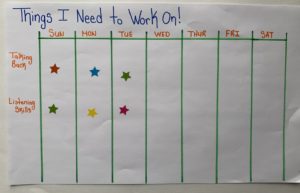
Over the years I have struggled with managing my son’s behaviour during our day-to-day routines, including epic meltdowns. The stress of handling some of these situations has led to my own share of “mommy meltdowns.” Parenting is the most rewarding experience of my life, but—as I’m sure you know—it can also be quite challenging.
As an educator, I have been exposed to a range of behaviours in children, and I have had many conversations with other parents about their children’s challenging behaviours. Because I am also speaking from the perspective of a parent, we have shared stories and laughter, and we have discussed similarities and differences. During these conversations with other parents, the topic of “strong-willed children” often came up. As a result of these discussions and my own parenting experiences, I began research and explore the characteristics of this term. This led me to discover that I am, if fact, raising a strong-willed child.
Please note: What follows describes my son’s extreme behaviours before I implemented my three tips, which I will discuss further below. Keep reading!
In the past, I experienced lengthy power struggles with my son, accompanied by exhausting meltdowns and tantrums. He had intense outbursts when he got angry. These eruptions usually resulted in him expressing his anger in ways that were not appropriate: stomping his feet, throwing himself down on the floor, screaming—you name it. His reactions were always overly dramatic for the situation. He was often very stubborn and bossy and always ready for a verbal fight. If there was something to be done that is unpleasant or not his ideal, he would sometimes refuse to do it.
My child likes to make his own rules—in the past, anything would work for him as long as he didn’t have to follow my rules. For example, bedtime is at 8:00 pm. Mesai used to make it his mission to get into his bed after 8. He would walk slowly or take multiple trips to the bathroom to slow down the bedtime routine. He chose to move at his own pace and sometimes it didn’t always work in his favour. He is starting to understand that. Children who are strong-willed often ignore warning signs they don’t really want to hear and that is something that I have noticed with my son. You can count down from a million or set timers, but when time is up he will often react as if there was no warning to begin with.
With these behaviours and characteristics in mind, I have implemented three different systems at home. These systems have helped reduce—and even eliminate—some of these challenging behaviours. The goal is to implement only a few things that contribute to improving most or all of the challenging behaviours.
MY 3 TOOLS
Visual Schedule
Visual schedules have completely changed my life. As an educator, this is something I use on a daily basis at school. But at first, I failed to see the value of using it at home. As soon as we started using a visual schedule at home (it’s on our fridge), it immediately reinforced positive behaviour for Mesai. Now he knows what is coming up next and what is expected of him day to day. He has become accustomed to a routine that he is comfortable with and that also gives him some flexibility and choices. He needs fewer reminders from me and certain power struggles have disappeared. For example, bath and homework were struggles, but now that they have specific times in the schedule, they’re no longer issues.
 I designed his schedule so that he is rewarded with play. After completing the most unpleasant task first, he earns time to do what he likes, which motivates him to get things done without the struggles. We have been following this routine consistently for about four months and Mesai can now implement the schedule without needing to see it visually. I purchased and downloaded my visual schedule on Etsy. After I printed and laminated it, I added magnets so I could put it on the fridge.
I designed his schedule so that he is rewarded with play. After completing the most unpleasant task first, he earns time to do what he likes, which motivates him to get things done without the struggles. We have been following this routine consistently for about four months and Mesai can now implement the schedule without needing to see it visually. I purchased and downloaded my visual schedule on Etsy. After I printed and laminated it, I added magnets so I could put it on the fridge.
Behavioural Charts
This is a fairly simple tool to use. On Sundays, I let Mesai decide what he wants to work on for the upcoming week. Often what needs to be worked on are things he struggled with the week before, such as listening skills or cleaning up after himself. We focus on two to three things that need improvement and write them on a chart we created. I keep the chart as simple as possible, as there is no need to make it complicated. At the end of each day I add a sticker (or don’t add one) depending on his behaviour. When a row of stickers is completed, he receives a special treat at the end of the week. It’s usually a big cookie from his grandmother. I’ve found that children do better when they have clear goals, just like us adults, and we all know that our brains get excited when we see visuals. This chart pushes me to acknowledge and encourage my son’s good behaviour. Without the aid of something like a chart, we can sometimes get caught up in the negative and forgot to focus on the positive.
I keep the chart as simple as possible, as there is no need to make it complicated. At the end of each day I add a sticker (or don’t add one) depending on his behaviour. When a row of stickers is completed, he receives a special treat at the end of the week. It’s usually a big cookie from his grandmother. I’ve found that children do better when they have clear goals, just like us adults, and we all know that our brains get excited when we see visuals. This chart pushes me to acknowledge and encourage my son’s good behaviour. Without the aid of something like a chart, we can sometimes get caught up in the negative and forgot to focus on the positive.
Social Stories
Although I have not been consistent with using social stories, I know they have helped other parents who have issues similar to mine. I have one picture book called “Even Superheroes Have Bad Days” by Shelly Becker.  It is a great book to validate big emotions when children are upset. As I mentioned, my son has big emotions that come with big outbursts, especially when he’s upset or mad. This is a great book for kids like him. Here’s one quote from the book to help you see the author’s approach: “Just like the rest of us, superheroes have bad days. They could use super-powers to cause a big scene. Or run amok and act super-mean. But even when they’re really, REALLY mad, they can’t – they won’t act super-bad.”
It is a great book to validate big emotions when children are upset. As I mentioned, my son has big emotions that come with big outbursts, especially when he’s upset or mad. This is a great book for kids like him. Here’s one quote from the book to help you see the author’s approach: “Just like the rest of us, superheroes have bad days. They could use super-powers to cause a big scene. Or run amok and act super-mean. But even when they’re really, REALLY mad, they can’t – they won’t act super-bad.”
What I’ve described in this post is just a sample of what might help you and your strong-willed child. There are so many other tools and resources out there to help support you. I encourage you to give the resources above a try and to do some research to see what might work best for you and your child. Just remember to keep it simple, easy and visual. Good luck and feel free to share your ideas and success!

These are great tips! Love the second one especially. I’ll just drop my kids at your place when I have them loooool
Author
Thanks for taking the time to read! and lol ummm haha
Loved these tools! I’m a mom of 4 and tips like these are definitely things I can apply to our daily routines. – Thanks Shan!
Author
Np! Glad you enjoyed the read. Implement them into your routine and let me know how it goes.
So the visual schedule will work for me in the morning. I don’t expect my daughter to be perfect but sometimes you may kiss a step and I would like to give her the confidence to be independent and have the help she needs. That one I definitely have to do!
Author
Yeah, for sure. It makes them feel that they are in control of their day. Try it out and let me know!
My daughter is also very strong willed ! The behavior chart works for us as well. They do it at school so it’s great reinforcement and routine for her.
Author
Yeah, I do love the chart. It has helped so much.